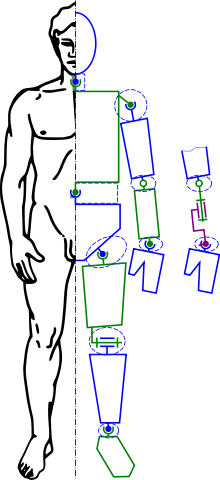
Back سلسلة حركية Arabic Кінематычны ланцуг Byelorussian Kinematische Kette German Chaîne cinématique (robotique) French Catena cinematica Italian ಚಲನಶೀಲ ಸರಪಳಿ Kannada Catena cinematica Latin Łańcuch kinematyczny Polish Кинематическая цепь Russian Кинематички ланац Serbian




In mechanical engineering, a kinematic chain is an assembly of rigid bodies connected by joints to provide constrained motion that is the mathematical model for a mechanical system.[1] As the word chain suggests, the rigid bodies, or links, are constrained by their connections to other links. An example is the simple open chain formed by links connected in series, like the usual chain, which is the kinematic model for a typical robot manipulator.[2]
Mathematical models of the connections, or joints, between two links are termed kinematic pairs. Kinematic pairs model the hinged and sliding joints fundamental to robotics, often called lower pairs and the surface contact joints critical to cams and gearing, called higher pairs. These joints are generally modeled as holonomic constraints. A kinematic diagram is a schematic of the mechanical system that shows the kinematic chain.
The modern use of kinematic chains includes compliance that arises from flexure joints in precision mechanisms, link compliance in compliant mechanisms and micro-electro-mechanical systems, and cable compliance in cable robotic and tensegrity systems.[3] [4]
- ^ Reuleaux, F., 1876 The Kinematics of Machinery, (trans. and annotated by A. B. W. Kennedy), reprinted by Dover, New York (1963)
- ^ J. M. McCarthy and G. S. Soh, 2010, Geometric Design of Linkages, Springer, New York.
- ^ Larry L. Howell, 2001, Compliant mechanisms, John Wiley & Sons.
- ^ Alexander Slocum, 1992, Precision Machine Design, SME
© MMXXIII Rich X Search. We shall prevail. All rights reserved. Rich X Search